3 Ways Your Website’s Design Affects SEO Rankings & Performance
It’s no secret that a website is a must-have marketing tool for businesses. What is a secret, to most business owners at least, is if web design impacts SEO rankings and performance?
The fact of the matter is your website’s design does impact SEO performance.
In this blog, we dive into the top three ways website design impacts SEO, including:
- Mobile-first web design and responsive websites
- Core Web Vitals
- Website conversion elements
But First, What Is SEO?
SEO is an acronym for search engine optimization. It’s the process of optimizing your website and its content to rank higher on Google search results. If you can achieve this, your website will earn more website traffic.
More traffic is great; however, the ultimate goal of SEO is to generate website conversions — phone calls, web forms, and chats. These conversions are qualified leads for your business to follow up on and sell. If you can increase conversions, your SEO campaign has done its job. After all, it is a marketing investment.
Before users convert on your website, they must first be able to find your website. Findability comes down to having a mobile-first website design that is easily found and crawled by Google.
Mobile-First Web Design: Design Your Site With End Users in Mind
Here’s a fun fact: Google’s algorithm uses mobile-first indexing. That means Google uses the mobile version of your website and its content for indexing (storing it in its database of results) and ranking.
If your website is not mobile-friendly and easily accessible on a smartphone, your website’s design has already affected its SEO performance — and not in a good way.
Traditionally, digital designers would design a site as it would appear on a desktop device (desktop computer or laptop). Then, the designer would re-create a similar yet different design entirely for mobile use.
That approach is now obsolete since more than 54% of all website traffic worldwide comes from mobile devices.
Google’s mobile-first indexing, combined with users’ preference to shop for goods and services on their phones, is why it’s critical to take a mobile-first approach to your website’s design.
Instead of designing your website for a laptop, first design your website as it would appear on a mobile device. Then, move on to the desktop experience.
Responsive Website Design Is the Way To Go
At Blue Corona, we recommend designing your website on a responsive framework.
A responsive website automatically adapts its layout and design to the specific device a user browses on — desktop PCs, laptops, tablets, and smartphones. In the blink of an eye, a responsive site recognizes the users’ device they are browsing from and instantly renders the website to match the device. Screen size, resolution, orientation, and interactive elements automatically adjust to the user’s device.
A responsive website doesn’t improve SEO performance, but it will ensure you’re not negatively affected by Google. That’s because Google’s crawlers will crawl the mobile version of your responsive site as part of its mobile-first indexing. If your website isn’t mobile-friendly, your SEO performance will be negatively affected.
To check if your website meets Google’s mobile-friendly guidelines, use Google’s mobile-friendly testing tool.
Core Web Vitals: Google’s Latest Push To Focus SEOs on Website Design & Functionality
In September 2021, Google completed its rollout of its Page Experience Update, which puts an emphasis on the usability of websites.
Specifically, Google added a new ranking factor into its algorithm in its Page Experience Update called Core Web Vitals.
Core Web Vitals are a set of metrics Google uses to measure user experience on a website. There are three metrics included in Core Web Vitals:
- Loading (Largest Contentful Paint or LCP) – Measures how long it takes for the largest content element (e.g., a banner image, video, contact form, etc.) on your page to become visible in the user’s window. Put simply, LCP measures how quickly your webpage loads.
- Interactivity (First Input Delay or FID) – Measures how quickly users can interact with your website in their browser. Keeping your website’s code lean by reducing third-party scripts will improve your site against FID.
- Visual Stability (Cumulative Layout Shift or CLS) – Measures the amount of visual change to your webpage after a user starts interacting with it. The lower the score, the better the experience for your website visitors, in Google’s mind at least.
In other words, Google wants your website to be easy to use. Here’s Google’s benchmarks it encourages websites to meet to pass Core Web Vitals:

How Does Website Design Affect Core Web Vitals & SEO?
Your website’s design affects Core Web Vital scores and SEO performance. Miss the mark, and your SEO performance may suffer.
The more complex your website’s design and functionality are, the harder it is to pass Core Web Vitals.
For example, videos, large images, animations, and other elements that impact a users’ overall experience on your website may hurt your SEO performance.
Once your website is designed, it’s up to an experienced web developer to implement these features in a Google-friendly way (minimizing third-party scripts, compressing images and videos, etc.) to ensure your website passes Core Web Vitals.
Conversion Elements: What Are They & How Do They Impact SEO? (Bonus: 3 Conversion Elements Every Home Service Website Must Have)
Depending on the type of business you run and your marketing goals, your site’s conversion elements might be different. For example, if an e-commerce business wants to sell more products via its website, one conversion element may be a button found on a product page reading “Add to Cart.”
We’re going to ignore e-commerce and focus on conversion elements every residential service business (e.g., HVAC, plumbing, electrical, roofing, landscaping, etc.) must have to positively affect SEO performance and increase qualified leads.
1.) Sticky Web Forms (Mobile) & Above-the-Fold Forms (Desktop)
Go to your website’s homepage on your phone, but don’t scroll. Do you see a sticky button on the bottom or top that leads to a web form?
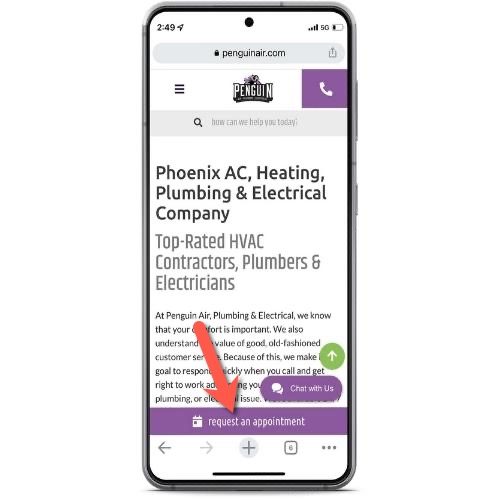
Similarly, visit your homepage on a laptop or desktop computer. Is a web form located “above-the-fold” and easily visible without scrolling?
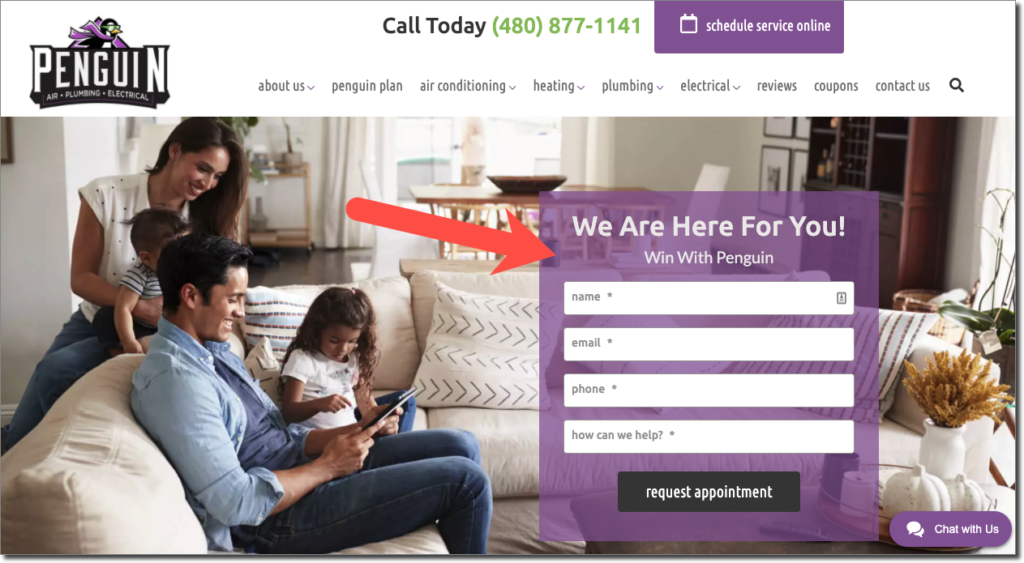
Now, navigate to another webpage. Again, don’t scroll anywhere. Does this webpage’s design also include an above-the-fold form on both mobile and desktop screens?
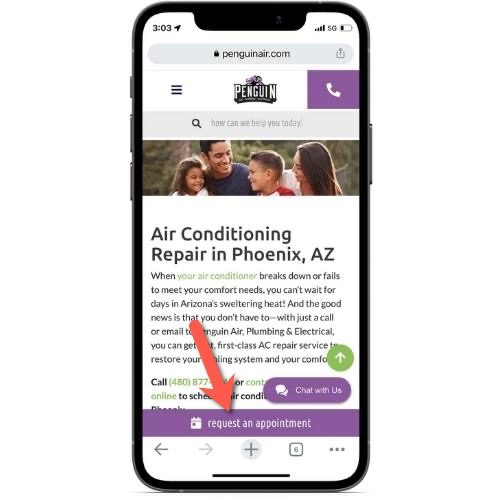
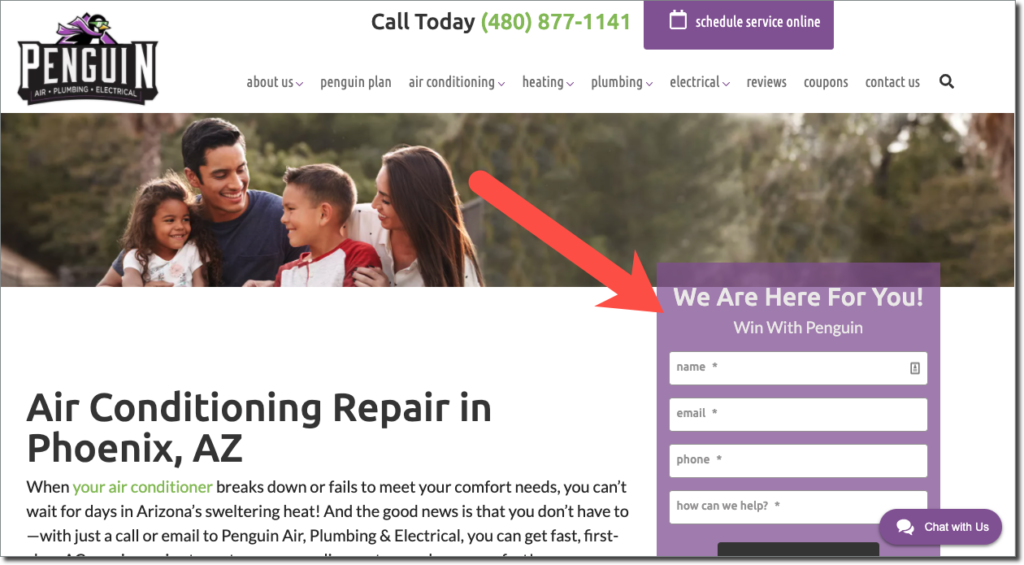
If you answered “yes” to these questions, great job. Your website already has one of the most important conversion elements every home service website must have to improve SEO performance and generate more qualified leads. It’s just one way that web design impacts SEO, let’s check out the others.
2.) Phone Numbers & Click-to-Call Buttons
Not every visitor to your website will want to fill out a form. Some need emergency service or simply prefer to pick up the phone and speak to someone.
For these visitors, it’s crucial to have your phone number at the top of your website on desktop and a sticky, click-to-call button on mobile devices. Forget these, and you can bet that your website’s design negatively affects conversions and SEO performance.
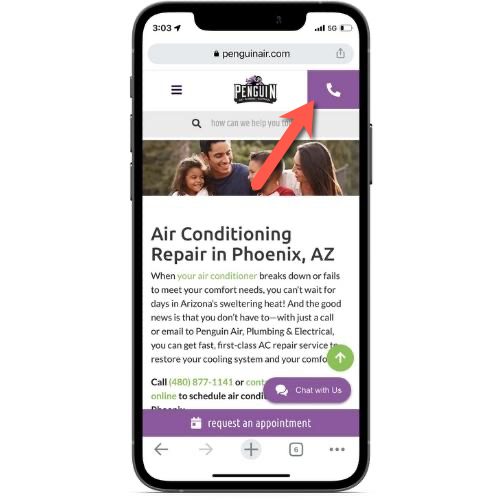
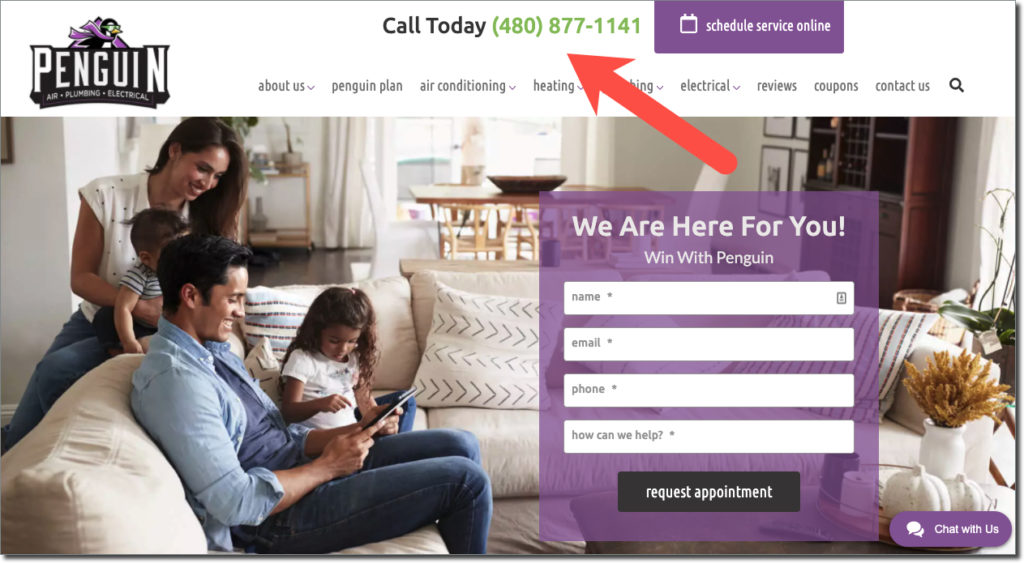
3.) Brand Differentiators
Nowadays, homeowners don’t know what contractor to call when they need a home repair or are ready to dive into their next home improvement project. In fact, according to Invoca, most consumers do not have a company in mind when searching online.
Percent of Customers That Did Not Have One Company in Mind When Searching
- Appliance repair – 80%
- Carpet cleaning – 74%
- Decks and patios – 83%
- Electrical – 90%
- Fencing – 84%
- Home remodeling – 68%
- House cleaning – 90%
- HVAC – 84%
- Lawn care – 80%
- Locksmith services – 88%
- Moving – 79%
- Painting – 86%
- Pest control – 83%
- Plumbing – 76%
- Roofing – 80%
Leverage Differentiators Through Design To Impact Conversions & SEO Performance Positively
Since homeowners aren’t loyal to one home service brand over others, you must showcase to users what makes you special.
Brand differentiation separates you from the competition and provides website visitors compelling reasons why they should call you and not the other guys:
- Customer reviews
- Real images of your team, office, trucks, warehouse, etc.
- Service areas
- Awards and accreditations
- Coupons, discounts, and promotional offers
- Etc.
Take a look at this website for Cranney Home Services, which wisely uses five unique differentiators to tell its website visitors why they’re the best in town:
- Cranney Value Plan
- Partner logos
- Customer reviews
- Why choose Cranney
- Coupons
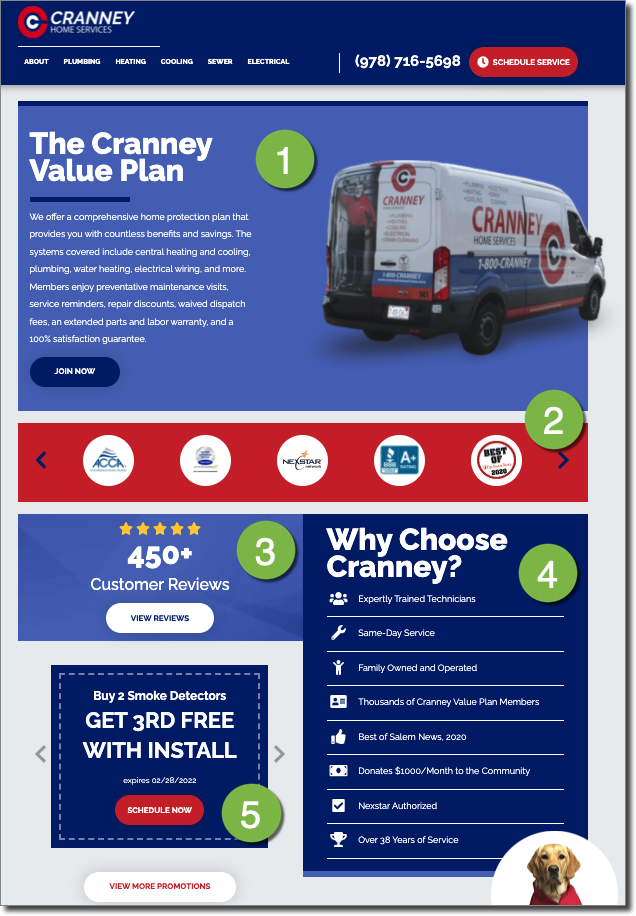
Web Developers: The Unsung Heroes of Web Design
A designer’s job is to design a beautiful website that makes you the authority online for the services you offer. A (good) designer will highlight your company’s differentiators while subtly encouraging users to convert into a qualified lead.
However, Google doesn’t view your website like a user, it “views” websites by crawling, reading, and interpreting its HTML code.
Here’s how a one Cleveland HVAC, plumbing, and electrical company’s website looks to visitors:
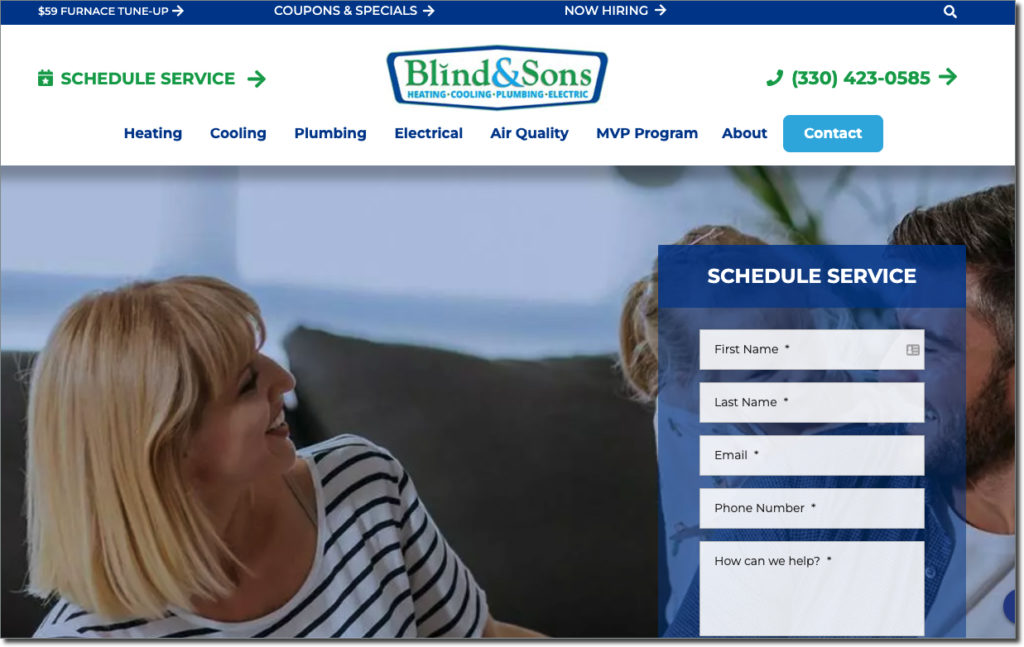
And here’s how Google views the same site:

A web developer’s job is to translate a beautiful design into HTML code that is easily crawled by Google and doesn’t take forever to load for users. The less code it takes to render the same design and functionality, the better. Lean websites are easily crawled by Google and load fast for users, both of which positively affect SEO performance.
Developers are the unsung heroes of great web design, building the bridge between design and SEO and ensuring that your website design doesn’t negatively impact your company’s SEO performance.
Recap: How Your Website’s Design Affects SEO
We said it before, and we’ll say it again — web design does affect SEO. However, it’s less impactful on your rankings and more impactful on conversions and the amount of qualified leads your website generates each month.
Great web design improves website conversion rates and helps you maximize your lead volume from website visitors.
Grow Your Business With Blue Corona
At Blue Corona, we focus on growing the trades. Nearly 400 home service businesses throughout the U.S. trust our team to design and build beautiful, conversion-friendly websites that also rank high on Google search.
Ready to take your digital marketing to the next level? Send us a message or give us a call to schedule a free marketing consultation!


Recent Comments